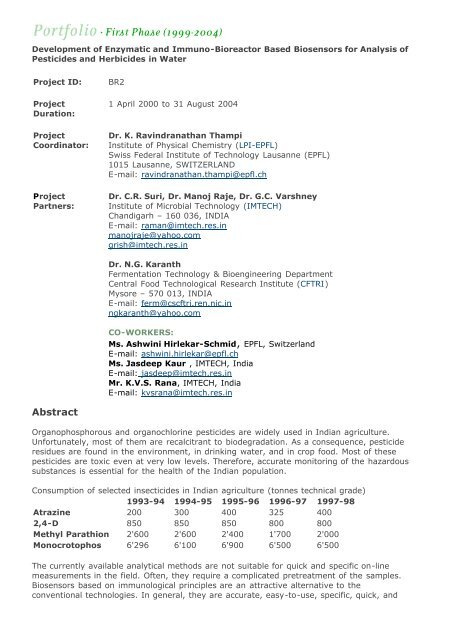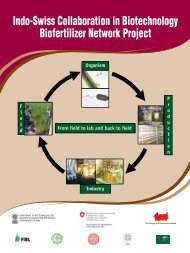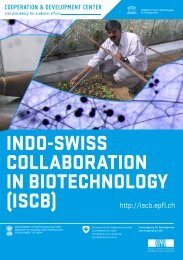BR2 - ISCB - EPFL
BR2 - ISCB - EPFL
BR2 - ISCB - EPFL
Create successful ePaper yourself
Turn your PDF publications into a flip-book with our unique Google optimized e-Paper software.
Development of Enzymatic and Immuno-Bioreactor Based Biosensors for Analysis of<br />
Pesticides and Herbicides in Water<br />
Project ID:<br />
<strong>BR2</strong><br />
Project<br />
Duration:<br />
1 April 2000 to 31 August 2004<br />
Project<br />
Coordinator:<br />
Dr. K. Ravindranathan Thampi<br />
Institute of Physical Chemistry (LPI-<strong>EPFL</strong>)<br />
Swiss Federal Institute of Technology Lausanne (<strong>EPFL</strong>)<br />
1015 Lausanne, SWITZERLAND<br />
E-mail: ravindranathan.thampi@epfl.ch<br />
Project<br />
Partners:<br />
Dr. C.R. Suri, Dr. Manoj Raje, Dr. G.C. Varshney<br />
Institute of Microbial Technology (IMTECH)<br />
Chandigarh – 160 036, INDIA<br />
E-mail: raman@imtech.res.in<br />
manojraje@yahoo.com<br />
grish@imtech.res.in<br />
Dr. N.G. Karanth<br />
Fermentation Technology & Bioengineering Department<br />
Central Food Technological Research Institute (CFTRI)<br />
Mysore – 570 013, INDIA<br />
E-mail: ferm@cscftri.ren.nic.in<br />
ngkaranth@yahoo.com<br />
CO-WORKERS:<br />
Ms. Ashwini Hirlekar-Schmid, <strong>EPFL</strong>, Switzerland<br />
E-mail: ashwini.hirlekar@epfl.ch<br />
Ms. Jasdeep Kaur , IMTECH, India<br />
E-mail: jasdeep@imtech.res.in<br />
Mr. K.V.S. Rana, IMTECH, India<br />
E-mail: kvsrana@imtech.res.in<br />
Abstract<br />
Organophosphorous and organochlorine pesticides are widely used in Indian agriculture.<br />
Unfortunately, most of them are recalcitrant to biodegradation. As a consequence, pesticide<br />
residues are found in the environment, in drinking water, and in crop food. Most of these<br />
pesticides are toxic even at very low levels. Therefore, accurate monitoring of the hazardous<br />
substances is essential for the health of the Indian population.<br />
Consumption of selected insecticides in Indian agriculture (tonnes technical grade)<br />
1993-94 1994-95 1995-96 1996-97 1997-98<br />
Atrazine 200 300 400 325 400<br />
2,4-D 850 850 850 800 800<br />
Methyl Parathion 2'600 2'600 2'400 1'700 2'000<br />
Monocrotophos 6'296 6'100 6'900 6'500 6'500<br />
The currently available analytical methods are not suitable for quick and specific on-line<br />
measurements in the field. Often, they require a complicated pretreatment of the samples.<br />
Biosensors based on immunological principles are an attractive alternative to the<br />
conventional technologies. In general, they are accurate, easy-to-use, specific, quick, and
available at a reasonable price.<br />
Project Rationale<br />
The overall goal of this project is to develop a simple, inexpensive immuno-biosensor, which<br />
will be used in the form of a portable analyser for rapid field and on-line determination of<br />
organophosphorous and organochlorine pesticides present in water at ng/l concentrations.<br />
To achieve these goals, the following tasks will have to be tackled:<br />
Development of two basic sample handling techniques, one for microreactor and one<br />
for SPR.<br />
Optimization of two detection techniques: fluorescence and SPR.<br />
Research Plan<br />
SUMMARY OF THE ACHIEVMENTS OF THE FIRST PROGRAM PHASE<br />
adapted from the summary provided by the project partners
Synthetic pesticides and herbicides are widely used in agriculture. Many of these are<br />
organochlorine and organophosphorous derivatives. Due to their recalcitrant nature, such<br />
toxins enter the food chain, causing serious risk to humans and animals. Therefore, it is<br />
essential to monitor their contamination in food, soil and water. The conventional analytical<br />
methods are not suitable for quick and specific field analyses. They are also expensive and<br />
laborious to apply. Biosensor based methods present an attractive alternative. In this<br />
concluded project, the development of biosensors useful for monitoring pesticides and<br />
herbicides was the prime objective. Biosensors based on enzymatic and immunological<br />
principles and modern detection systems not only present an effective solution to this<br />
vexing problem, but also a value-added product with good potential for commercialization<br />
and gainful job creation. Manpower training, scientific exchange between India and<br />
Switzerland and proliferation of knowledge between developed and developing countries<br />
were other important benefits expected from this project. A joint project comprising four<br />
different labs from India and Switzerland (IMTECH, Chandigarh; CFTRI, Mysore; <strong>EPFL</strong>,<br />
Lausanne, institutes LPI and LCPPM; IMT, Neuchatel), having interdisciplinary and<br />
complimentary expertise, was formed in order to develop sensitive, analyte specific, easy to<br />
use and cost-effective biosensor devices for monitoring pesticide samples in aqueous media.<br />
LPI-<strong>EPFL</strong> functioned as the overall project coordinator.<br />
The partners chose 5 pesticides (insecticides and herbicides) for the biosensor development.<br />
These were methyl and ethyl parathions, 2,4-dichlorophenoxy acetic acid (2,4-D), atrazine<br />
and monochrotophos. The primary task was to develop good quality polyclonal antibodies<br />
against these molecules. Secondly, appropriate assay techniques to individually detect up to<br />
nano (ppb) or sub-nanogram (ppt) levels of these molecules in water were required. CFTRI<br />
accepted the responsibility of developing polyclonal antibodies suitable for the 2 types of<br />
parathions. Monochrotophos was kept as a molecule to be studied after completing the work<br />
with parathions, since parathions are still widely used in India with serious harmful<br />
consequences. IMTECH selected atrazine and 2,4-D as their target molecules, particularly<br />
since the manufacture and use of these two compounds are rapidly increasing in India .<br />
Apart from the development and characterization of antibodies, the Indian labs were also<br />
involved in assay and transducer development. <strong>EPFL</strong> was involved in identifying appropriate<br />
detection methods, antibody-antigen interactions and pre-concentration methods. The preselected<br />
detection methods were surface plasmon resonance (SPR) and fluorescence. IMT ,<br />
NE was involved in developing a Si (silicon) based micro-machined flow-device platform for<br />
repeated multiple use. In order to select the best option, the efficacy of the two detection<br />
methods was reviewed towards the end of the first two years, based on the actual<br />
experience and performance data of the developed antibodies. SPR was abandoned at that<br />
point, as this method was less sensitive with small molecules in comparison to fluorescence<br />
techniques. However, the work in CFTRI and <strong>EPFL</strong> also showed that chemiluminescence<br />
could be an equally competitive method for detecting pesticides in low concentration levels.<br />
Therefore, fluorescence and chemiluminescence were finally chosen as the suitable detection<br />
methods. Neverthless, at <strong>EPFL</strong>, SPR functioned throughout as an excellent workhorse in<br />
characterising the generated antibodies and evaluating their purity and specificity.<br />
IMTECH produced both polyclonal and monoclonal antibodies, which reached ppm limits of<br />
detection. CFTRI clearly showed that large quantities of polyclonal antibodies against<br />
parathions could be produced through egg-yolks of poultry. This method avoids the<br />
traditional production of antibodies in rabbit blood. Both CFTRI and IMTECH used appropriate<br />
conjugation chemistry for making haptens and optimized the conditions for obtaining best<br />
quality antibodies. Hapten-protein conjugates with different hapten density were made by<br />
chemical modification of selected organic toxins and subsequently linking covalently with<br />
suitable carrier proteins (BSA and KLH). The developed conjugates were thoroughly<br />
characterized by various methods such as UV, fluorescence, SDS-PAGE, MALDI etc., in order<br />
to optimize the hapten-protein conjugation density. The suitable conjugates were used as<br />
immunogens for the purpose of antibody generation. Specific antibodies were screened out<br />
using various affinity purification techniques. Hapten columns were designed for getting<br />
specific antibodies from the serum. Antibodies of different binding characteristics were eluted<br />
using suitable elution buffers and characterized by ELISA, SPR and Western blot techniques.<br />
These antibodies were used for different immunoassay formats.
In the case of 2,4-D and atrazine, highly sensitive hapten-fluorophore tracer molecules<br />
using different fluorophores (FITC/RITC) and colloidal gold particles were made for their use<br />
in fluorescence based immunoassay and dipstick applications. An on-line fluoroimmunosensor<br />
was developed for the quantification of 2,4-D and atrazine in aqueous<br />
samples. A noble hapten-protein-gold conjugate as detector molecule was also developed<br />
for dipstick applications for the detection of atrazine and 2,4-D in water. The concentration<br />
of antigen in test media was correlated with the change in intensity of the tracer signal. The<br />
dipsticks were evaluated and tested under various field conditions. The transfer of this<br />
technology to one USA company is under negotiation. Upon a request from the company, a<br />
few dipstick samples and anti-atrazine antibodies were sent for evaluation purpose.<br />
Chemiluminescence methods detected parathions with sensitivity up to sub-nanogram levels.<br />
A critical factor in this case was the stabilization of the enzyme conjugate at nanomole<br />
concentrations. Basic information on the production and immobilization of antibodies, and<br />
data on several parametric optimizations of the bioreactor column and the resulting sensor<br />
performance were generated. Several microreactors were designed and fabricated by IMT ,<br />
NE. The microreactors' chambers were designed to obtain high packing homogeneity and<br />
fluid distribution to prevent channelling effects. The final microreactor consisted in a flowthrough<br />
chamber of approx 7 µl, at the end of which 6 interleaved rows of posts were<br />
machined to retain the packing material. Prototypes were fabricated by Deep Reactive Ion<br />
Etching (DRIE) to decrease the mesh size, to allow the use of Ø 25 µm beads and to further<br />
improve the surface-to-volume ratio. The optical cell was integrated on a chip and consisted<br />
in a simple flow through cell of 0.5 µl. Good packing/unpacking properties and flow<br />
distribution were observed. Fluidic resistance was measured and was in good agreement<br />
with the theoretical model. A number of cartridge prototypes were sent to the project<br />
partners for evaluation. A generic fluid handling system was developed to interface the<br />
chemiluminescent and fluorescent assays. External pumps and valves were selected to<br />
control the incubation, the washing and the elution step. A user interface was developed<br />
under a NI Labview platform to control the fluid motion and the data acquisition. An optical<br />
system was also made to improve detection performances and robustness. This<br />
configuration was evaluated against a bench top laser-induced fluorescence confocal<br />
microscope, developed in-house. A detection limit of 0.2 ng/µL for fluorescein at pH 7.4 was<br />
achieved with a simple light-emitting device. However, following the development of the<br />
dipstick method, the microfluidic approach was suspended to better focus on the task and<br />
achieve the target in the shortest time possible.<br />
Besides the evaluation of detection methods and project coordination, investigations of<br />
antibody-antigen interaction using SPR, AFM and microcalorimetry were carried out at <strong>EPFL</strong>.<br />
IMTECH, CFTRI and <strong>EPFL</strong> jointly developed a method for the site-directed immobilization of<br />
antibodies on gold substrates for SPR applications. A freshly prepared gold surface on a<br />
glass carrier slide was modified with Protein A via a homobifunctional cross linker to achieve<br />
uniform, stable and sterically accessible antibody coating. The modified gold surface was<br />
found to be stable, repeatedly usable for several measurements and the experimental<br />
reproducibility was good.<br />
During the International Workshop on Biosensors held at CFTRI in 2003, the results of the<br />
project were discussed and biosensor kits were demonstrated to international experts. The<br />
progress of the project was well appreciated. It was felt that the results achieved so far<br />
should be seriously pursued towards the construction of an integrated biosensor device for<br />
immediate application and commercialization. In the light of the very positive results<br />
obtained; a new project is therefore planned to fabricate integrated biosensor devices in<br />
collaboration with suitable industrial partners.<br />
In brief, at the close of the project, the partners have developed biosensor methods to<br />
quantitatively detect parathions using chemiluminescent techniques up to sub-nanogram<br />
levels of contamination. It must be mentioned that an immunobioreactor-based biosensor<br />
for pesticides based on the chemiluminescence principle is being developed for the first time<br />
to detect pesticides at ppt level. The high sensitivities of detection achieved in the project<br />
promise excellent applications and exhibit very good potential for making future fieldapplicable<br />
devices. For 2,4-D and atrazine, dipstick kits are now available for a Yes/No type
qualitative detection up to ppm levels. For parathions, polyclonal antibodies were produced<br />
using egg yolk. As a result of this project, both polyclonal and monoclonal antibodies are<br />
now available for atrazine and 2,4-D. There is a clear need for developing Yes/no type<br />
dipsticks also for the detection of parathions at sub-nanogram level. Similarly, the existing<br />
dipstick's sensitivity should be improved to sub-nanogram level. Further, field level<br />
validation and industrial collaboration to make commercial prototypes are urgently required.<br />
These issues and some more useful complexities will be addressed in the research plan of<br />
the second phase, which is expected to run during the 2005-2007 period.





